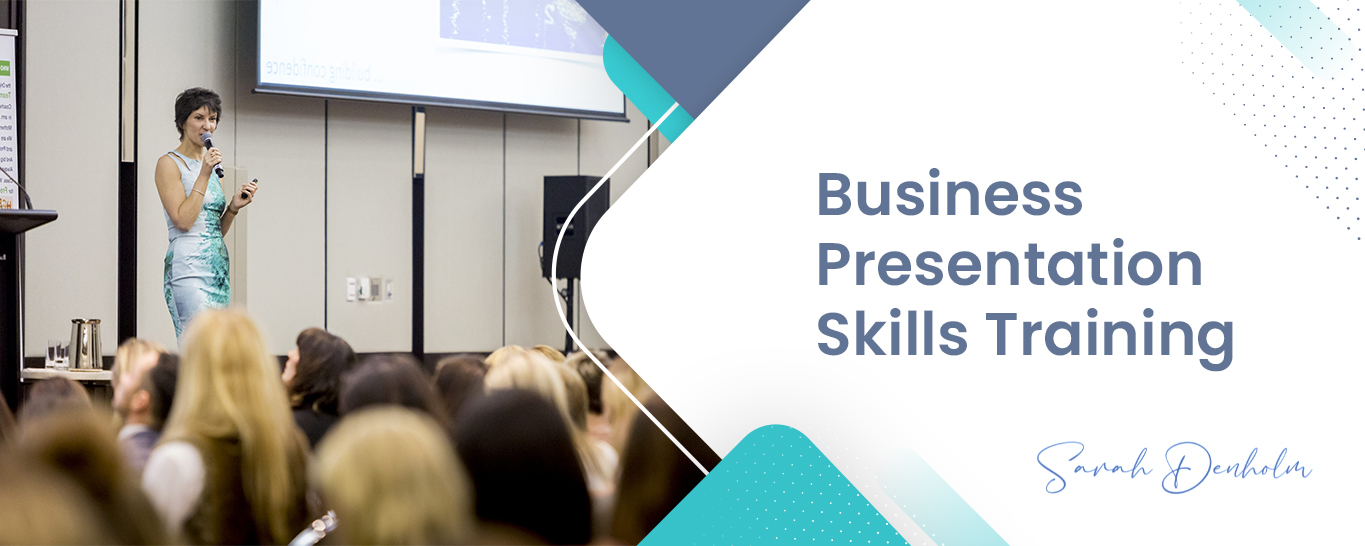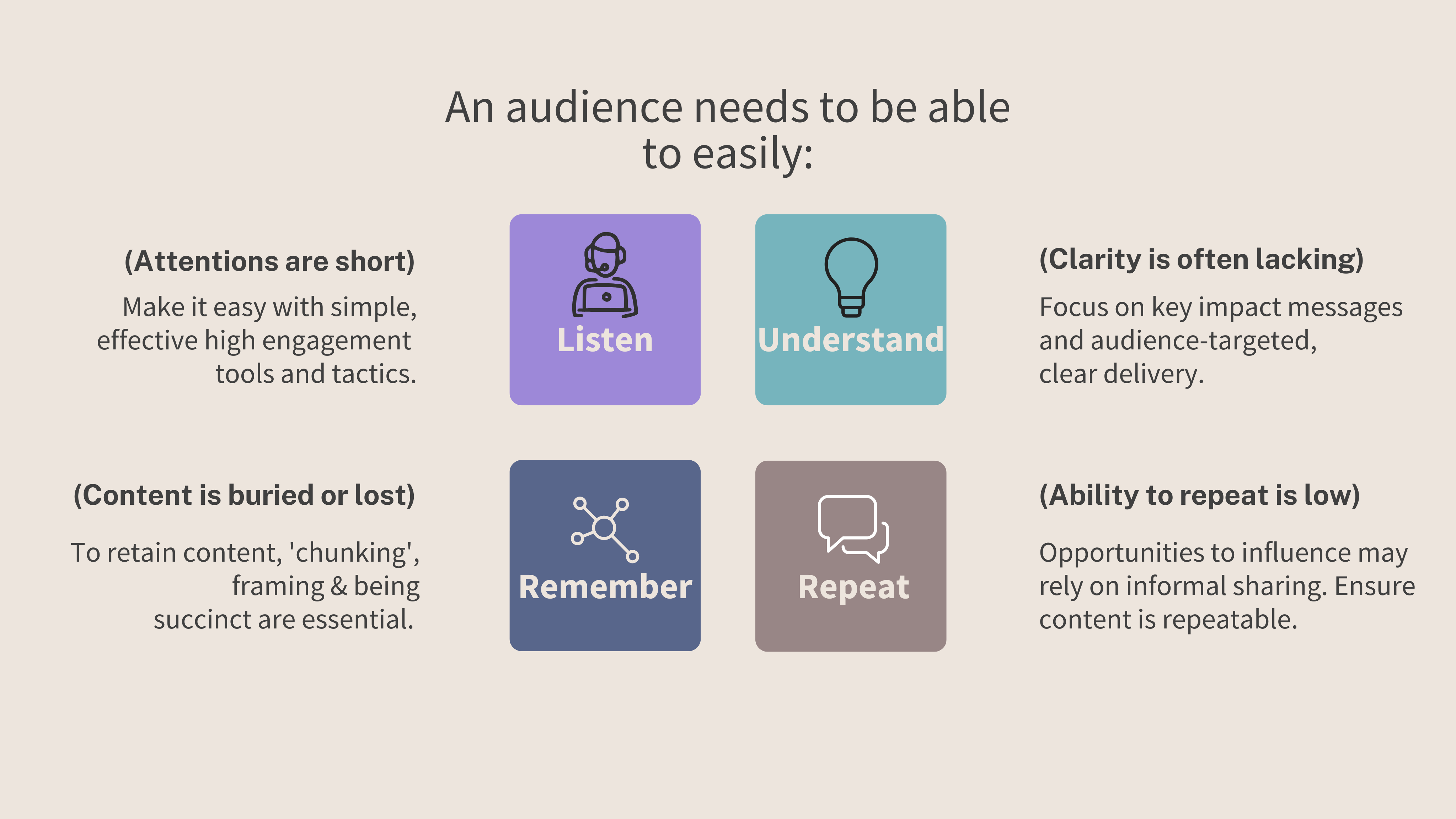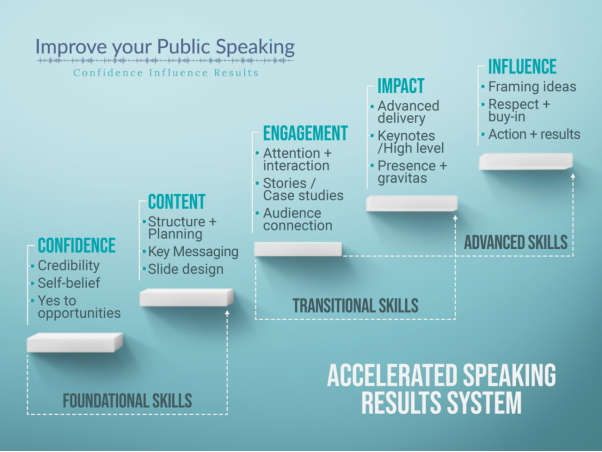
Business Presentation Skills Training & Courses
Your organisation’s success is directly related to your people’s ability to communicate ideas effectively. To engage and influence – confidently, persuasively, and consistently.
And of course these ideas are often communicated through a presentation, delivered in a room or virtually.
Communication is no longer a ‘soft’ skill, but a crucial edge in business. If your people can communicate in ways that grab – and hold – attention, they will stand out in a sea of dull, long-winded or unclear presentations: whether they are delivering to an internal or external audience.
To gain attention for the right reasons, there need to be various elements successfully in place – and these elements usually apply even with less dynamic presentations like a status update. Let’s look at a presentation from an audience’s perspective:

Very well presented and engaging for such a large group of people
The workshop provided me with lots of tips that I can go back and look through when I am presenting next but also I got validation of things I already do well.
The session was incredibly informative and Sarah created a great environment where people felt comfortable learning and trying.
It was very professional and informative without being alienating. Sarah has recognised that people often don’t feel comfortable with the topic and has worked hard to make it a welcoming space.
And how are we judged as a presenter?
We’re judged on these factors – or lack of them – and more:
- Confidence levels
- Clarity
- Connection capacity
- Engagement ability
- Influencing and persuasive skills
If you lack confidence (or seem to): this can be seen as lacking confidence in your knowledge level, content, offer or service. And you may not be considered ready for promotion, hiring, or worth listening to. This is harsh – but we know it can be true.
If you’re not clear: this is – clearly – a major problem! And it’s remarkably common. A lot of effective business presentation skills training and coaching is about creating or building clarity.
If you don’t build connection by resonating at some level with your audience, you may fail in your presentation goals. And interestingly, this can happen when presenters are too confident, as well as when they’re lacking in this area.
If you don’t engage effectively: your audience will be disconnected, confused or bored. Even threatened by your presentation if they don’t understand it: humans don’t like to feel stupid or ‘behind’ in understanding. Particularly in front of others.
If you don’t influence and persuade in the right ways: well, this is obvious. You miss opportunities. And sometimes, an opportunity may only come along once.
My business presentation skills training involves any or all of the above elements. The Accelerated Speaking Results model is a clear way to show the 5 levels of training and coaching available:

These are the lenses through which I work to get results:
Visual
how we look (body language, behaviours and ‘image’)
Vocal
how we sound (tone, presence, variety)
Verbal
our words (written and spoken)
Who these business presentation courses are for
The training can be pitched at any level of the Accelerated staircase above: foundational, transitional or advanced skills. Or it can be customised as a combination of all three levels; the choice is yours.
It can therefore apply to frontline teams, managers, supervisors and team leaders, right up to executive and board level.
Where it’s useful
Internal examples:
- Different departments needing to clearly communicate, to enable your organisation to deliver its best work.
- Project updates
- Town halls
- Monthly sales meetings
- Team or supplier briefings
External examples:
- Client presentations: for example, talking clearly and succinctly through the reasons and decisions made or suggested to clients.
How it works
You receive customised, practical, interactive and enjoyable sessions, with the goal of permanently embedding new strategies and skills which will transform your people’s ability to create and deliver great presentations.
Participants bring along work-specific content, which is then workshopped during the sessions. It’s exceptionally practical, fast paced, fun and tailored for participant needs.
Everyone has the opportunity to deliver in some capacity, depending on the numbers and format chosen. And participants receive safe, individualised, constructive feedback. Videotaping is also available depending on group size.
Location and delivery
The training can be delivered face-to-face, hybrid (in room/online) and fully virtual.
Course and workshop length options
The training can be run over anything from 2 hours to 2 days.
Participant numbers
3 – 100+ depending on the type of sessions chosen.
Examples of what can be covered
- Speaking habits
These are crucial because any habit that isn’t conscious will potentially make the speaker look either not self-aware, or nervous. Neither will build credibility and authority in the eyes of an audience.
There may be unconscious or unhelpful habits or biases around visual, vocal or verbal elements such as gestures, ‘filler’ words, powerless word choices, vocal cues and triggers.
Learn evidence-based, tested tools for these habits – what to add, tweak or drop.
- Engagement and connection tools and pitfalls like:
- Top ‘filters’ that kill listener engagement
- Stories or case studies that really work
- My ‘Circles of Speaking Disconnection’ and what to do about them
- How to read the room, and adjust style if required
And everything learned will still allow ‘realness’ and authenticity.
Learning Outcomes — examples
Delivery and preparation skills to demonstrate clarity and presence.
Working effectively with slides or visuals.
Flexible, effective structures and frameworks for clarity, impact and influence.
Sharp, succinct and refined language and key messages.
Specific techniques to build trust and authority fast.
Managing questions or different/difficult audiences.
Audience engagement and ability to retain information.
To look at just some of the organisations Sarah’s worked with over the past 14 years, and real testimonials about her corporate public speaking and presentation courses, check out the Client Results page.
So, to improve the skills of your people, permanently and easily, get in touch with Sarah to discuss how she can help by designing and delivering the best business presentation skills training option for your organisation.

Our consultants found it a delight and a pleasure working with Sarah. Her modules were constructed with content that were grounded in psychology and human behavior. Her practical tips and approaches were well received too. During her workshops, Sarah was able to draw out the most reluctant of our consultants and make them participate enthusiastically.
The sessions were thoroughly enjoyable while being educational and practical. Thank you, Sarah. We have no hesitation in recommending Sarah’s course to others who are looking for such programs.
Sarah provided my team with practical, useful tools to overcome nerves, improve their speaking skills and engage their audience. She created a warm, dynamic atmosphere which encouraged sharing of ideas and goals. Sarah provided specific, useful feedback for each participant, and was flexible in tailoring her training to the needs of the group as they progressed.
I would highly recommend Sarah, and would use her services again without hesitation. She gets great results, is personable, and expert at what she does.
My Team had certified Project Managers and we were delivering projects successfully, but I realized quickly that good public speaking and presentation skills are integral part of project delivery.
I did google search on public speaking and found Sarah’s website. The website and client results and Sarah herself looked so real that I couldn’t help contacting her. We immediately engaged her and the three workshops she did for us with over ten participants from my Team was a huge success.
In fact, a Team member who dreaded public speaking, did the best presentation during the third workshop! The workshops were fun, we learned from each other, we encouraged each other and more importantly the learnings are lifelong!
Personally, for me, I kept taking guidance from Sarah even after her official engagement was over with us. She was very supportive, and I have no hesitation in saying that Sarah – you have been an integral part of my journey from Manager to Director. I am sure you will form many more careers and help many more professionals achieve their goals.
Sarah provided training in public speaking to the LiverWELL team last week and we were able to see an improvement in our skills within one day! Sarah managed the diverse requirements of our staff and lived experience speakers with sensitivity and warmth. A combination of experience, expert advice, science and a little humour made it a highly valuable and enjoyable day. I would highly recommend Sarah.
Sarah Denholm is a great teacher. She is kind and gentle and works in a very positive way with people. She has a knack of building confidence and giving people the skills they need.
Last year I was overseeing the management of a group of 20 projects for a large Melbourne-based company. Sarah was engaged to improve the presentation skills of Project Managers who were expected to present their progress to the CEO and senior board members regularly, and felt unprepared for the task ahead of them. She came into the group, quickly established rapport with all the staff and was able to assist them in a very short timeframe. There was noticeable improvement in the way the staff presented themselves and their confidence grew rapidly.
We felt very privileged to have been able to work with Sarah and I believe that the skills each person gained will stand them in good stead in many roles throughout their careers.
About me
I’ve been coaching, consulting and mentoring in public speaking and presentation skills for over 13 years. Plus many years on stage as a classical pianist before that.
I work with clients worldwide in organisations from the UN to Deutsche Bank.
To find out more about my background and story, visit the About Sarah page, or my LinkedIn profile.

